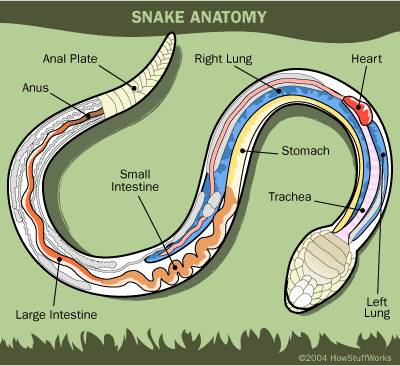
Coral Snake
Ancestory and Evolution
Body Structure
Eastern
Feeding
Reproduction
Western
Coral Snake Body
The most obvious features of snakes are their elongated body and lack of limbs. Primitive snakes often have remnants of pelvic girdles and hind limbs. These can be seen as tiny spurs or cloacal claws and are relics of the snake’s lizard like ancestors. The skeleton of most snakes consists of only a skull, a long vertebral column, and ribs. The spine is fairly uniform along the whole of its length and contains between 150 – 450 vertebrae, each with a pair of ribs. The vertebrae are linked by ball and socket joints, and by wing like projections or processes that limit the movement of each vertebrae to about 25 degrees each way. This prevents damage to the spinal cord, which runs through the center of the backbone, and protects the blood vessels and nerves that run alongside it.
In primitive snakes, the skull is fairly rigid, but most snakes have very flexible skulls. The upper and lower jaws are loosely connected and can come apart from each other and from the braincase or cranium. Enabling snakes to swallow prey much larger than themselves. The teeth are often curved strongly backward, and in most poisonous species one pair, the fangs, is enlarged and used to inject venom. The majority of snakes have teeth in both lower and upper jaws, and these include the coral snakes.
With all species, the goal in life is to survive and reproduce, and the animal’s boy structure and composition certainly takes a huge role in said matter. Snakes must feed so that they can grow to maturity, yet at the same time they must avoid being eaten by other animals. In order to do all this, they must move around, and be able to do so ideally, yet this is no easy task for an animal without legs. However so, the snake manages to accomplish this.

If a snake manages to avoid predators and find enough food to survive it must also deal with the problem of finding another mate with which to reproduce with. All of these actions are typically behavioral actions, yet there are also biological and chemical actions that must occur perfectly. Along the lines of feeding, snakes must also swallow and digest the prey, which depend on the snakes internal anatomy and biochemistry. In essence, the snakes behavioral, physical, and biochemical processes must be in unison in order for the creature to thrive. Accordingly, this section of the website will focus on the snakes body composition and how all of the pieces fit together in order to make an extraordinarily adaptable creature.